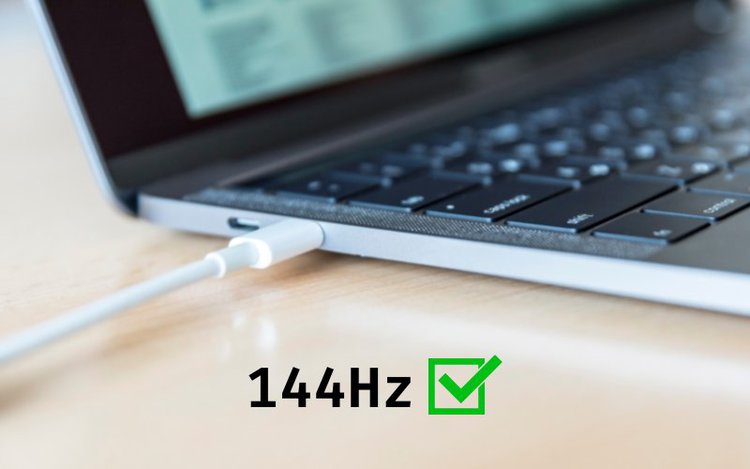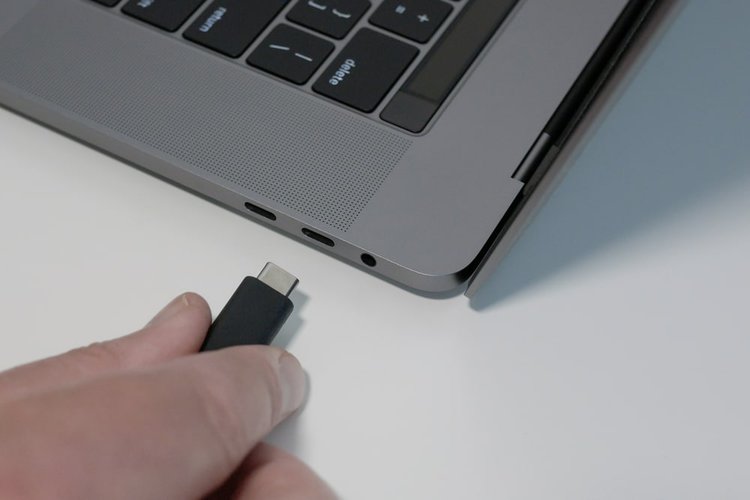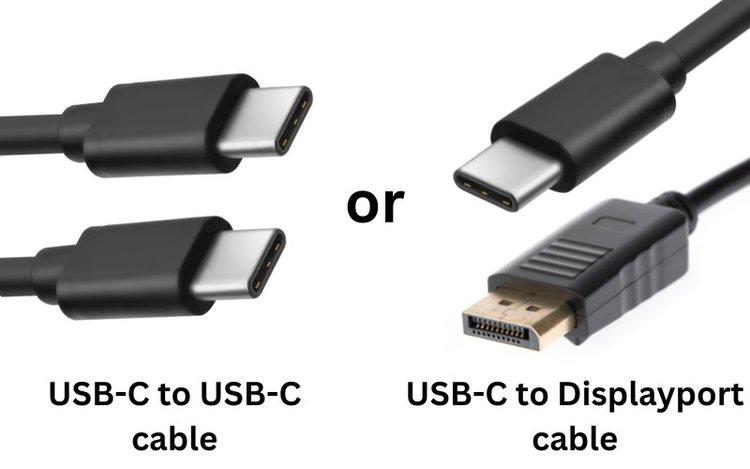USB-C Max Refresh Rate: Can It Handle 144Hz Gaming Glory?

- USB-C cables can support a 144Hz refresh rate if the source device’s USB-C port is compatible with DisplayPort Alternate Mode or Thunderbolt 3 or 4.
- To determine if a device supports Alternate Mode or Thunderbolt, look for a Thunderbolt logo or a DisplayPort logo (“P” inside “D”) next to its USB-C port.
If you’re an avid gamer, you know how much your cable’s refresh rate can affect gameplay. You used to connect your video source to your display with an HDMI cable, but you recently got a new laptop with a USB-C port.
But can you connect your laptop to a display with a USB-C cable and still consume content at 144Hz? If so, how do you know if your device supports this setup?
Keep reading to find out!
Quick Navigation
Can I Get 144Hz With USB-C?
Yes, you can watch content at 144Hz with a USB-C cable.

However, in order to do this your source device’s USB-C port must be compatible with either DisplayPort Alternate Mode or Thunderbolt 3 or 4, as these are the few interfaces that currently support this refresh rate.
DisplayPort Alternate Mode, which allows USB-C to transmit video and audio, supports a 4K video resolution at a 144Hz refresh rate. In addition to supporting USB-C, it also supports HDMI 2.0. While HDMI 2.0 can display 4K images, it only supports a 60Hz refresh rate.
Unlike DisplayPort Alternate Mode, Thunderbolt is not a display interface. Instead, it simply supports DisplayPort and HDMI connections to display video/audio on your output source.
Although Thunderbolt 3 and 4 look the same, they are compatible with different DisplayPort versions.
Thunderbolt 3 is compatible with DisplayPort version 1.4 and below. While all manufacturers must make their Thunderbolt 3 ports compatible with DisplayPort 1.2, only select brands include DisplayPort 1.4 on their devices. Both versions support 4K resolutions at 144Hz.
On the other hand, Thunderbolt 4 supports DisplayPort 2.0. While this DisplayPort version can display up to a 16K picture resolution at 60Hz, it can also support 4K at 144Hz.
Is My Device Compatible With Alternate Mode or Thunderbolt?
Let’s learn how to tell if your device is compatible with Alternate Mode or Thunderbolt.
Head to the back or side of your output device and look for its USB-C ports. Once you’ve found them, check if there’s a small Thunderbolt logo (see image below) next to one of them.
Alternatively, there may be a DisplayPort logo, which looks like the letter “P” inside the letter “D.”
If you see either one of these logos next to a USB-C port, then it supports DisplayPort Alternate Mode.
Oftentimes, only one of your device’s USB-C ports will support Alternate Mode, so only plug your USB-C cable into the port directly next to the logo.

However, some manufacturers will not include these logos next to their USB-C ports even if they do support Alternate Mode. So, it’s best to consult your device’s specs sheet or consult the manufacturer’s customer service to double-check the ports’ capabilities.
Which Cables are Compatible With Alternate Mode or Thunderbolt?

There are two types of cables that are compatible with Alternate Mode or Thunderbolt.
Only specific USB-C to USB-C cables support video/audio signals. So, you must ensure it’s Thunderbolt-compatible if you want to use it for a Thunderbolt display.
Alternatively, you can use a USB-C to DisplayPort cable, which has a USB-C connector on one end and a DisplayPort connector on another. Unlike Thunderbolt-compatible cables, these cables do not need to support DisplayPort Alternate Mode.
Recommended Cables:
Pluggable Thunderbolt 3 Cable
The Pluggable Thunderbolt 3 Cable is a Thunderbolt-compatible USB-C cable used to connect to USB-C-compatible devices. It’s bi-directional, so you can plug either end into your input or output source with the same results.
- More Possibilities: Thunderbolt 3 cable with 20Gbps speed and USB 3.0 5Gbps compatibility; supports...
- Streamlined Productivity: Daisy chain up to 6 Thunderbolt devices, including docking stations,...
- Apple Notes: Thunderbolt 3 uses the USB-C connector built into late 2016 MacBook Pros and newer...
(Paid Link.)
It comes in two lengths: 0.8 meters and two meters, depending on your setup.
CABLEDECONN USB-C to DisplayPort Cable
If you’re looking for a high-quality cable to connect your DisplayPort-compatible output device to your DisplayPort Alternate Mode-compatible video source, look no further than the CABLEDECONN USB-C to DisplayPort Cable.
- USB-C Type C to Displayport Cable connects your USB Type-C device such as a MacBook or ChromeBook to...
- 8K UHD DISPLAYPORT Video Resolution Support for Ultra High Definition Resolutions up to...
- USB C to DP cable converter supports the newest computers with Thunderbolt 3(Type-c) ports; widely...
(Paid Link.)
Simply plug the cable’s DisplayPort end into your TV, projector, or monitor. Then, plug the cable’s USB-C end into your DisplayPort Alternate Mode-compatible video source, be it a laptop or gaming console.
The longest available length is three meters, allowing you to set up your video source at a comfortable distance from your TV without tugging on the cable.
Wrapping Things Up
You can absolutely get 144Hz with USB-C, but there are a few things to consider before you start connecting your video source to your display.
The first thing to consider is if your output source’s USB-C ports support DisplayPort Alternate Mode, or Thunderbolt 3 or 4. If you find a Thunderbolt or DisplayPort logo next to the USB-C port, then you know you’re good to go.
The second thing to consider is which cable you’re using. USB-C to USB-C cables must support Thunderbolt. You may also use a USB-C to DisplayPort cable if your output source supports DisplayPort.
Once you’ve confirmed these two hardware specs, you’re ready to connect everything and watch content from your USB-C-compatible video source!
Have you ever tried connecting a video source to your display with a USB-C cable?
Let us know in the comments below!
Yesenia Achlim is a technical copywriter and editor with a focus on AV equipment. She aims to break down complicated topics and make technology accessible, no matter your technical expertise. When she’s not teaching you how to replace a projector lamp, you can find her reading and baking.

![Plugable Thunderbolt 3 Cable 20Gbps Supports 100W (20V, 5A) Charging, 6.6ft / 2m USB C Compatible [Thunderbolt 3 Certified] - Driverless](https://m.media-amazon.com/images/I/319HdVvop0L.jpg)

